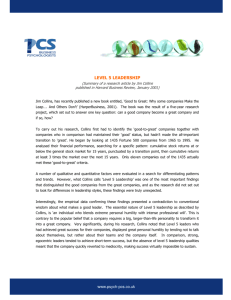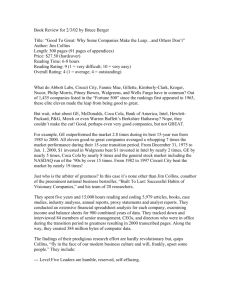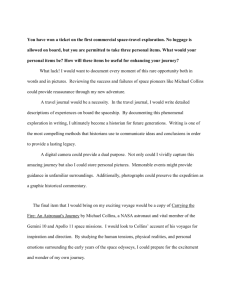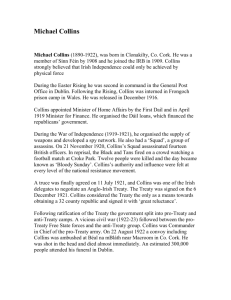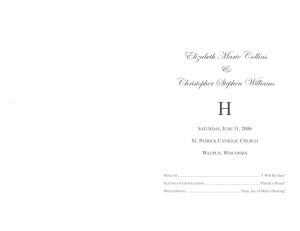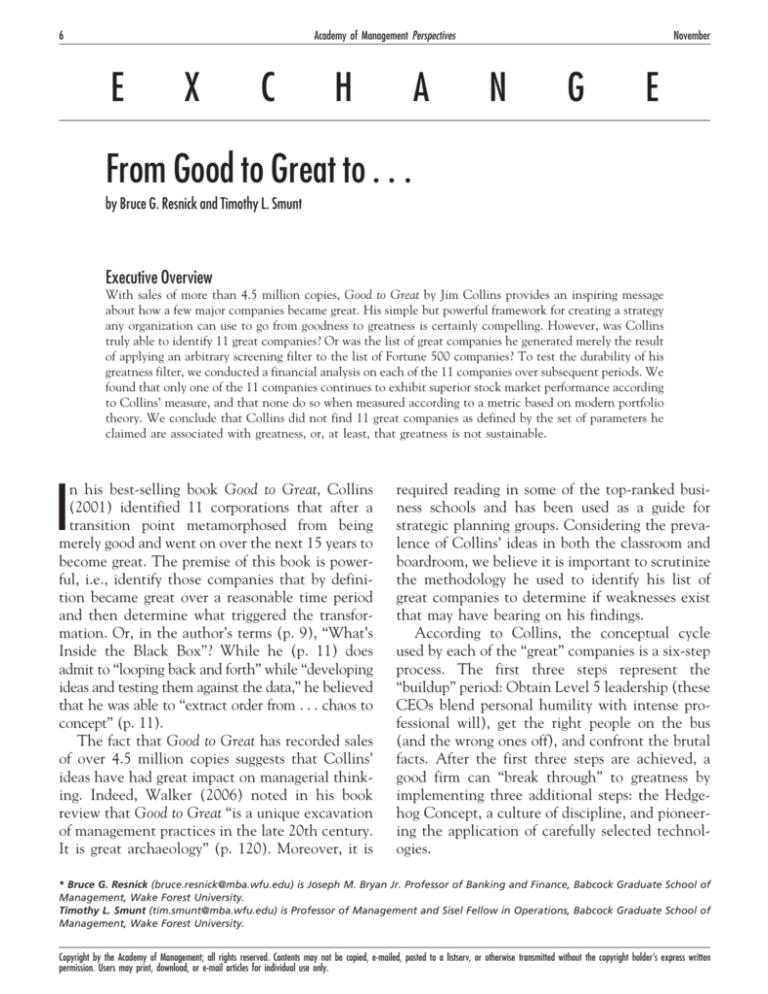
6
Academy of Management Perspectives
E
X
C
H
A
November
N
G
E
From Good to Great to . . .
by Bruce G. Resnick and Timothy L. Smunt
Executive Overview
With sales of more than 4.5 million copies, Good to Great by Jim Collins provides an inspiring message
about how a few major companies became great. His simple but powerful framework for creating a strategy
any organization can use to go from goodness to greatness is certainly compelling. However, was Collins
truly able to identify 11 great companies? Or was the list of great companies he generated merely the result
of applying an arbitrary screening filter to the list of Fortune 500 companies? To test the durability of his
greatness filter, we conducted a financial analysis on each of the 11 companies over subsequent periods. We
found that only one of the 11 companies continues to exhibit superior stock market performance according
to Collins’ measure, and that none do so when measured according to a metric based on modern portfolio
theory. We conclude that Collins did not find 11 great companies as defined by the set of parameters he
claimed are associated with greatness, or, at least, that greatness is not sustainable.
I
n his best-selling book Good to Great, Collins
(2001) identified 11 corporations that after a
transition point metamorphosed from being
merely good and went on over the next 15 years to
become great. The premise of this book is powerful, i.e., identify those companies that by definition became great over a reasonable time period
and then determine what triggered the transformation. Or, in the author’s terms (p. 9), “What’s
Inside the Black Box”? While he (p. 11) does
admit to “looping back and forth” while “developing
ideas and testing them against the data,” he believed
that he was able to “extract order from . . . chaos to
concept” (p. 11).
The fact that Good to Great has recorded sales
of over 4.5 million copies suggests that Collins’
ideas have had great impact on managerial thinking. Indeed, Walker (2006) noted in his book
review that Good to Great “is a unique excavation
of management practices in the late 20th century.
It is great archaeology” (p. 120). Moreover, it is
required reading in some of the top-ranked business schools and has been used as a guide for
strategic planning groups. Considering the prevalence of Collins’ ideas in both the classroom and
boardroom, we believe it is important to scrutinize
the methodology he used to identify his list of
great companies to determine if weaknesses exist
that may have bearing on his findings.
According to Collins, the conceptual cycle
used by each of the “great” companies is a six-step
process. The first three steps represent the
“buildup” period: Obtain Level 5 leadership (these
CEOs blend personal humility with intense professional will), get the right people on the bus
(and the wrong ones off), and confront the brutal
facts. After the first three steps are achieved, a
good firm can “break through” to greatness by
implementing three additional steps: the Hedgehog Concept, a culture of discipline, and pioneering the application of carefully selected technologies.
* Bruce G. Resnick (bruce.resnick@mba.wfu.edu) is Joseph M. Bryan Jr. Professor of Banking and Finance, Babcock Graduate School of
Management, Wake Forest University.
Timothy L. Smunt (tim.smunt@mba.wfu.edu) is Professor of Management and Sisel Fellow in Operations, Babcock Graduate School of
Management, Wake Forest University.
Copyright by the Academy of Management; all rights reserved. Contents may not be copied, e-mailed, posted to a listserv, or otherwise transmitted without the copyright holder’s express written
permission. Users may print, download, or e-mail articles for individual use only.
2008
Resnick and Smunt
Collins claimed that his study team was able to
identify 11 companies, each of which was able to
find something that lay at the intersection of what
they could “be the best in the world at,” drove
their “economic engine,” and were “deeply passionate about” doing (p. 95–96), thus resulting in
the superior financial performance they subsequently exhibited. In fact, Collins claimed that
“to go from good to great requires a deep understanding of . . . [these intersecting concepts that
translate] . . . into a simple, crystalline concept
(the Hedgehog Concept)” (p. 118). As an absolute measure of having achieved greatness, Collins
required that the cumulative stock market performance of a company had to be at least three times
the performance of the general market over the
15-year transformation period. He claimed to
have picked three times the market “because it
exceeds the performance of most widely acknowledged great companies” (p. 6). A good company
merely had a ratio of at least 1.25 times the
performance of the market.
Collins writes that “we developed all of the
concepts . . . by making empirical deductions directly from the data” (p. 10).1 He goes on to say
that by applying the Good to Great concepts to
either a start-up or an established organization, a
business leader can “create sustained great results”
(p. 190). Can his assertion be accepted? Can anything about great management really be gathered
from ex post financial analysis that identifies a
handful of companies that generated superior
stock market performance? We recognize that
Collins’ methodology can be viewed as an important first step in generating hypotheses about what
causes companies to become “great.” However, if
exceptional stock market performance is a mark of
sustained greatness, it follows that the 11 firms
identified by Collins will have gone on to exhibit
continued great stock market performance. If they
have not, one is left to question whether Collins
really identified great firms and/or whether his
prescription for greatness is valid. In the next
section, we directly test Collins’ hypotheses about
1
We believe Collins means induction rather than deduction because
he does not start from a theory of management and then deduce conclusions from it.
7
having 1) identified great firms that 2) sustained
their greatness through continued great stock market performance.
Methodology and Empirical Results
e first attempted to replicate Collins’ results using the same database he used, the
monthly total stock return files prepared by
the University of Chicago Center for Research in
Security Prices. Each of the 11 great companies
identified by Collins exhibited cumulative stock
market performance of at least three times the
performance of the general market (as measured
by the Standard and Poor’s 500 stock market
index) over the 15 years following the year T in
which the transition occurred. Since there are 16
years in the period T ⫹ 15 years and Collins does
not identify precisely in which month the transition occurred, the subsequent 15 years could run
from January of year T through December of year
T ⫹ 14 (earliest possible) or January of year T ⫹
1 through December of year T ⫹ 15 (latest possible).
The middle column of Table 1 shows the ratio
of cumulative stock returns relative to the general
stock market for the 15 years following the transition point for each of the 11 Good to Great
companies as reported by Collins (2001, p. 7). For
example, the 3.98 ratio for Abbott indicates that
over the 15-year time period encompassed by 1974
to 1989, an investment in Abbott returned $3.98
for each dollar invested in an index fund designed
to replicate the performance of the S&P 500.
Table 1 also shows for each of the 11 Good to
Great companies the corresponding ratio for the
earliest possible and latest possible 15-year periods. Examination of Table 1 shows that most of
our ratios are similar to those reported by Collins.
However, some are quite different. For example,
our ratios for Circuit City range from 7.37 to 14.92
times the market, compared to Collins’ ratio of
18.50. Obviously, the value of the ratio is quite
sensitive to the specific 15 years (180 months)
selected within the T ⫹ 15-year time span. Moreover, our analysis shows that Kimberly-Clark does
not meet the three times market criterion if either
the earliest or latest possible 15-year period is used
to calculate the cumulative ratios. Similarly, nei-
W
8
Academy of Management Perspectives
November
Table 1
Results from Transition Period to 15 Years beyond the Transition Pointa
Company
Year T to
T ⫹ 15
Reported by
Collins
Earliest Possible
15-Year Period
Latest Possible
15-Year Period
Abbott
Circuit City
Fannie Mae
Gillette
Kimberly-Clark
Kroger
Nucor
Philip Morris
Pitney Bowes
Walgreens
Wells Fargo
1974–1989
1982–1997
1984–1999
1980–1995
1972–1987
1973–1988
1975–1990
1964–1979
1973–1988
1975–1990
1983–1998
3.98 times market
18.50 times market
7.56 times market
7.39 times market
3.42 times market
4.17 times market
5.16 times market
7.06 times market
7.16 times market
7.34 times market
3.99 times market
3.89 times market
14.92 times market
4.23 times market
5.18 times market
2.56 times market
2.61 times market
4.09 times market
7.81 times market
3.53 times market
6.53 times market
3.88 times market
3.02 times market
7.37 times market
4.72 times market
6.18 times market
2.49 times market
4.70 times market
4.32 times market
7.86 times market
7.45 times market
7.79 times market
2.79 times market
a
This table shows the ratio of cumulative stock returns to the general stock market for the 15 years following the transition point for
each of the 11 Good to Great companies as reported by Collins (2001, p. 7). Since the T ⫹ 15 period encompasses 16 years, and it is not
reported by Collins in which month the transition period started, for comparison purposes we also report ratios calculated from January
of year T through December of year T ⫹14 (earliest possible) and those beginning in January of Year T ⫹ 1 and ending in December of year
T ⫹ 15 (latest possible).
ther does Kroger if the earliest possible 15-year
period is used, or Wells Fargo if the latest is used.
It is startling to us that some of the great companies would not have been classified as such if their
performance results were tabulated starting a few
months differently from the starting month selected. Our results show a lack of robustness of
Collins’ methodology and suggest that the list of
great companies is a result of data mining—i.e.,
iterating through the data until a particular starting month was found that resulted in a cumulative
stock market performance ratio of at least three
times the performance of the general market over
the subsequent 15 years. The problem with this is
that it opens the door to questions about whether
Collins’ conclusions can be generalized, because
the determination of whether a company was
great does not always hold if data from even a
slightly different period is used.
As previously noted, if exceptional stock market performance is a mark of sustained greatness, it
follows that the 11 firms identified by Collins will
have gone on to exhibit continued great stock
market performance. If they have not, one is left
to question whether Collins really identified great
firms and/or whether his prescription for greatness
is valid. We now test this proposition using additional data. Table 2 presents analysis of the stock
market performance for each of the 11 Good to
Great companies subsequent to the respective periods analyzed by Collins. Fortunately, nine continue to exist as independent companies, which
allows us to track their performance. In 2003, the
name of Philip Morris Companies was changed to
Altria Group. In 1998, Wells Fargo and Norwest
merged into a single company under the name
Wells Fargo. Additionally, in 2005, Gillette and
Procter & Gamble merged into a single company
under the name of the latter. Our post-study analysis assumes that an original investment in Wells
Fargo and Gillette continues as an investment in
the respective new company. Our assumptions are
that Wells Fargo’s management practices were
instituted in the combined firm and that Procter
& Gamble acquired Gillette partly because its
management practices would have a favorable effect on the combined firm.2
The first post-study time period we analyzed
is from January of year T ⫹ 16 through December of 2006, i.e., the longest period of time from
the end of Collins’ analysis. For example, for
Abbott the starting month is January 1990. The
2
Readers uncomfortable with these assumptions may safely ignore the
post-study results for these two firms and concentrate on the other nine
without any loss to the generality of our conclusions.
2008
Resnick and Smunt
9
Table 2
Post Study Actual Performance Results vs. Benchmark Performance Resultsa
Company
Year T ⫹ 16 to
December 2006
Cumulative Ratio
Post 1995 Fortune
500 Ranking
Abbott
Circuit City
Fannie Mae
Gillette/Procter & Gamble
Kimberly-Clark
Kroger
Nucor
Philip Morris (Altria)
Pitney Bowes
Walgreens
Wells Fargo
1990–2006
1998–2006
2000–2006
1996–2006
1988–2006
1989–2006
1991–2006
1980–2006
1989–2006
1991–2006
1999–2006
1.46 vs. 3.47 times market
.97 vs. 1.93 times market
1.00 vs. 1.67 times market
1.01 vs. 2.24 times market
1.04 vs. 4.02 times market
1.35 vs. 3.74 times market
2.83 vs. 3.23 times market
6.37 vs. 7.22 times market
.91 vs. 3.74 times market
2.70 vs. 3.23 times market
1.65 vs. 1.80 times market
1996–2006
1998–2006
2000–2006
1996–2006
1996–2006
1996–2006
1996–2006
1996–2006
1996–2006
1996–2006
1999–2006
Cumulative Ratio
1.09 vs. 2.24 times market
.97 vs. 1.93 times market
1.00 vs. 1.67 times market
1.01 vs. 2.24 times market
.76 vs. 2.24 times market
.88 vs. 2.24 times market
1.62 vs. 2.24 times market
1.75 vs. 2.24 times market
.95 vs. 2.24 times market
2.32 vs. 2.24 times market
1.65 vs. 1.80 times market
a
This table shows the actual ratio of cumulative stock returns to the general stock market versus the benchmark performance for each
of the 11 Good to Great companies for two periods subsequent to the 15 years studied by Collins (2001). The first post-study period covers
the time from the end of Collins’ analysis, year T ⫹ 16 through December 2006. The second post-study period covers the time subsequent
to the company’s listing in the 1995 Fortune 500.
second post-study time period is from January
1996 through December 2006. This time period
is relevant because one of Collins’ criteria was
that each of the 11 great companies had to be
included on the 1995 Fortune 500 list. Annually, Fortune magazine ranks U.S.-based publicly
traded companies by revenue; the largest 500
comprise the Fortune 500. These companies are
among the largest, most profitable, and most
powerful companies in the United States. The
criterion that the great firms had to be listed on
the 1995 Fortune 500 list means that an inconsistent methodology was applied to their selection because they were not all analyzed over a
common time period. For example, Abbott was
analyzed over the 15-year time period of 1974
through December 1989, but the 1995 Fortune
500 listing requirement assured that it was still
an ongoing corporation in 1995 (six years later),
and likely one of considerable financial
strength. On the other hand, Gillette was analyzed over the 15-year time period of 1980
through 1995, without any requirement that it
still be an ongoing firm listed on the Fortune
500 list six years later in 2001. While Gillette
did not fall off the Fortune 500 list over the
next six years, for some reason it conceivably
could have, meaning that it would not have met
the same longevity standard as did Abbott. We
believe a more legitimate post-study analysis
that eliminates differences in selection criteria
begins in January 1996, or in January of year
T ⫹ 16 if that date occurs later, i.e., dates
falling after the 1995 Fortune 500 listing requirement.3
Table 2 presents the cumulative stock return
ratio relative to the general stock market for
each of the 11 companies over each of the two
post-study time periods. Because these time periods are not 15 years in length, a multiple of
three times the general market is an inappropriate benchmark for determining greatness. Instead we calculate a unique benchmark ratio for
each stock using the equivalent annual rate.
That is, a ratio of three generated over 15 years
implies an annual return in excess of the market
return of 7.599% [⫽ (31⁄15 – 1) x 100%]. Consequently, while Abbott generated a cumulative
stock return ratio of 1.46 times the general
stock market over the T ⫹ 16 through 2006
study period, it falls short of its relevant benchmark of 3.47 [⫽ (1.07599)17] over the 17 years
3
The date corresponding to January of year T ⫹ 16 occurs concurrently or after January 1996 for Circuit City, Gillette/Procter & Gamble,
Fannie Mae, and Wells Fargo. Consequently, the two post-study test results
presented in Table 2 will be the same for these companies.
10
Academy of Management Perspectives
November
Table 3
Jensen’s Alpha Measure of Performance and Stock Betaa
Year T to T Year ⫹ 15
Year T ⫹ 16 to December 2006
Post 1995 Fortune 500
Ranking
Company
Alpha
Beta
Alpha
Beta
Alpha
Beta
Abbott
Circuit City
Fannie Mae
Gillette/Procter & Gamble
Kimberly-Clark
Kroger
Nucor
Philip Morris (Altria)
Pitney Bowes
Walgreens
Wells Fargo
.0078* (2.01)
.0155 (1.82)
.0082 (1.61)
.0118* (2.59)
.0066 (1.51)
.0118* (1.97)
.0104 (1.66)
.0133* (2.92)
.0135* (2.62)
.0131* (2.61)
.0065 (1.27)
.93* (11.15)
1.28* (6.31)
1.32* (11.46)
1.06* (9.93)
.82* (9.39)
.80* (6.62)
1.55* (11.37)
.99* (9.21)
1.09* (10.35)
1.28* (11.80)
1.21* (10.45)
.0056 (1.40)
.0130 (0.81)
.0015 (0.18)
.0040 (0.66)
.0037 (1.00)
.0054 (1.02)
.0081 (1.27)
.0095* (2.39)
.0023 (0.58)
.0094 (1.92)
.0070 (1.07)
.53* (5.46)
1.96* (5.36)
.30 (1.49)
.62* (4.54)
.60* (6.41)
.78* (5.90)
1.20* (7.49)
.73* (8.04)
.79* (7.90)
.63* (5.16)
.37* (2.31)
.0048 (0.92)
.0130 (0.81)
.0015 (0.18)
.0040 (0.66)
.0020 (0.37)
.0038 (0.60)
.0065 (0.82)
.0105 (1.38)
.0032 (0.60)
.0108 (1.70)
.0070 (1.07)
.44* (3.58)
1.96* (5.36)
.30 (1.49)
.62* (4.54)
.44* (3.56)
.47* (3.21)
1.32* (7.17)
.41* (2.32)
.57* (4.74)
.55* (3.75)
.37* (2.31)
a
This table shows the Jensen’s alpha measure of abnormal performance relative to the general stock market and the beta for each of
the 11 Good to Great companies for three periods: the (latest possible) 15 years studied by Collins (2001); the time subsequent to the
Collins’ study, year T ⫹ 16 through December 2006; and, the time subsequent to the company’s listing in the 1995 Fortune 500.
* Denotes statistical significance at the two-tailed 5% level. Associated t-statistics are in parentheses.
encompassing 1990 through 2006. Examination
of Table 2 shows that each of the 11 companies
falls short of its relevant benchmark over the
first post-study period and that only Walgreens
beats its benchmark over the second post-study
period. Moreover, two companies, Circuit City
and Pitney Bowes, have a ratio less than unity
over both post-study periods, and two others,
Kimberly-Clark and Kroger, have a ratio less
than unity over our second post-study period,
indicating that these companies did not even
match general stock market performance. Overall, Table 2 suggests that only Walgreens has
exhibited any manner of sustained great results
when measured by cumulative stock market performance relative to the general stock market.
Collins’ methodology of measuring relative
stock market performance of the 11 great firms
versus the general market lacks sophistication, in
particular the ability to adjust for performance
differences associated with risk. Financial economists are interested in whether exceptional stock
market performance is truly higher once one accounts for the costs of risk and then whether the
performance differences are statistically significant. Jensen’s (1968, 1969) alpha provides a mea-
sure of abnormal risk-adjusted stock performance
relative to the general market:
Mean Excess Stock Return ⫽ Alpha ⫹ Beta
⫻ Mean Excess Market Return.
According to theoretical ideas about the efficiency of the stock market like the capital asset
pricing model,4 Jensen’s alpha should be zero. A
statistically significant positive (negative) value
would indicate superior (inferior) stock return
performance. Beta is a measure of the stock’s systematic, or market, risk and is theoretically the
only risk priced by the market.
We repeat Collins’ tests adjusting the returns of
the companies for variations in the risk level of
their stock. Table 3 presents the Jensen’s alpha
performance measure and beta for each of the 11
great companies calculated over three time periods: the January T ⫹ 1 through December T ⫹ 15
(approximate) period studied by Collins, the poststudy period of January T ⫹16 through December
2006, and the post-1995 Fortune 500 listing period through December 2006. Examination of the
4
See Sharpe (1964).
2008
Resnick and Smunt
table shows that all 11 great companies had a
positive alpha over Collins’ study period. However, the alphas of five companies, Circuit City,
Fannie Mae, Kimberly-Clark, Nucor, and Wells
Fargo, were not statistically significant and thus
would not be classified as exhibiting superior performance according to modern portfolio theory.5
Over our first post-study period, all alphas were
positive, but only one company, Philip Morris,
yielded a statistically significant alpha. And over
the post-1995 Fortune 500 study period, all alphas
were positive, but none was statistically significant. In summary, the results show that some of
the 11 companies would not have been selected as
great if their performance had been measured according to modern portfolio theory and that not a
single company has exhibited sustained success
when measured by statistically significant abnormal stock market performance.
Summary and Conclusion
ur analysis of Collins’ Good to Great study
methodology suggests that it suffered from
three major problems: 1) data mining with
respect to the selection of the starting month of
the company transformation period, 2) the failure
to test for the sustainability of greatness over subsequent time periods, and 3) the failure to use
modern portfolio theory that accounts for the
costs of risk and then whether the performance
differences are statistically significant.
We have shown that data mining was likely
used in the selection of the 11 great companies
and that some would not have been classified as
great if their performance results were tabulated
starting a few months differently from the starting
month selected. This opens the door to questions
about whether Collins’ conclusions can be generalized because the determination of whether a
company was great does not always hold if data
from even a slightly different period is used.
Collins claimed that his study team was able to
O
5
According to the capital asset pricing model, a stock with a beta of
1.5 implies that if the general market increases 1%, the stock’s return will
increase 1.5%. This explains how a stock such as Fannie Mae, with a beta
of 1.32, can produce a cumulative stock return ratio of 7.56 times the
general stock market over Collins’ study period, yet have a statistically
insignificant Jensen’s alpha of .0082.
11
identify 11 companies that by virtue of their management practices were able to transform themselves from good companies to great ones, and
that from the analysis of their management practices he was able to ascertain the management
traits that made them great and resulted in the
superior financial performance they subsequently
exhibited. To qualify as great, a company had to
yield a cumulative stock market performance ratio
of at least three times the performance of the
general market over its 15-year transformation
period. Collins claimed that by applying the Good
to Great concepts, to either a start-up or an established organization, a business leader can create
sustained great results. If exceptional stock market
performance is a mark of sustained greatness, it
follows that the 11 firms identified by Collins will
have gone on to exhibit continued great stock
market performance. If they have not, one is left
to question whether Collins really identified great
firms and/or whether his prescription for greatness
is valid. We tested this proposition using new data
and found that only one of the 11 companies
continues to exhibit superior stock market performance according to Collins’ measure. Consequently, doubt is cast on whether Collins has
actually ascertained management practices that
lead to sustained greatness.
Finally, we repeated Collins’ tests adjusting the
returns of the companies for variations in the risk
level of their stock using the capital asset pricing
model. This allowed for determining whether the
11 companies produced statistically significant abnormal performance relative to the general stock
market. We found that five of the 11 companies
did not produce statistically significant positive
abnormal performance and thus would not have
been selected as great if the performance metric
were based on modern portfolio theory. Moreover,
when using the new data, we found that not a
single company exhibits sustained success when
measured by statistically significant abnormal
stock market performance.
Exceptional stock market performance will occur when the market is first unaware, but then
learns, of positive things happening within a corporation—whether these things qualify as a move
from good to great or merely a move from poor to
12
Academy of Management Perspectives
good. Regardless, as the market incorporates the
new relevant information into the stock price, the
stock will no longer earn statistically significant
positive abnormal returns. We cannot definitively
say whether greatness was ever created at any of
these 11 firms. Collins’ tests do not allow for
determining whether a great firm has truly been
identified. He may have identified great companies and he may not have; we do not know. We do
know, however, that he defines a great company
as one that yields superior stock market performance and claims that application of his managerial formula will lead to “sustained greatness.” In
this context, “sustained greatness” can only mean
continued superior stock market performance. We
have shown that this has not been the case either
by his measurement or by Jensen’s alpha. According to modern portfolio theory, some of these 11
companies should never have been classified as
November
great. Moreover, the fact that none of the 11
companies currently has a significantly positive
alpha suggests that the market now appears to be
fully aware of whatever the managerial abilities
are at all of these corporations and has priced their
stocks according to their market risk.
References
Collins, J. (2001). Good to great. New York: HarperCollins.
Jensen, M. C. (1968). The performance of mutual funds in
the period 1945–1964. Journal of Finance, 23(2), 389 –
416.
Jensen, M. C. (1969). Risk, the pricing of capital assets, and
the evaluation of investment portfolios. Journal of Business, 42(2), 167–185.
Sharpe, W. F. (1964). Capital asset prices: A theory of
market equilibrium under conditions of risk. Journal of
Finance, 19(3), 425– 442.
Walker, G. (2006). Good to great: Why some companies
make the leap—and others don’t. [Review of the book
Good to great]. Academy of Management Perspectives,
20(1), 120 –122.

